

6.18.24
Laura Dattaro
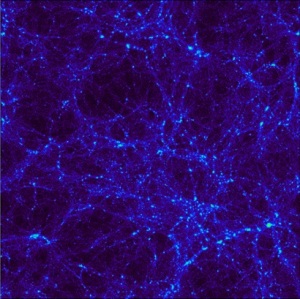
Physicists are preparing for the next generation of dark-matter experiments.
Imagine all the matter in the universe is a set of billiard balls on a pool table, each awaiting the cue ball’s strike. If you wanted to maximize the odds of hitting any ball, you could make the cue ball enormous, essentially guaranteeing it would bump into something on its lumbering path. But if you couldn’t change the size of the cue ball, another option would be to blanket the table in billiard balls in hopes that the regular-sized cue ball couldn’t sneak past.
This is the approach physicists use when directly searching for dark matter, says Daniel Akerib, the interim associate lab director for the Fundamental Physics Directorate at SLAC National Accelerator Laboratory.
Because physicists can’t influence dark matter itself—the cue ball—they stuff their detectors with as many metaphorical billiard balls as they can. “All we can do is stick more atoms in front of it,” Akerib says.
Akerib works on LUX-ZEPLIN, one of the largest experiments currently looking for dark matter in this way [see Dark Matter Background below].
At the end of 2023, a panel tasked with enumerating the priorities of the US particle physics community included in its report a plan to build an even bigger, next-generation dark-matter experiment [P5 Report]. This year in May, a representative of the Department of Energy—one of the largest funders of US particle physics—announced its support for that recommendation.
The specifics of a next-generation dark-matter detector are still to be determined, says Regina Rameika, associate director of DOE’s Office of High Energy Physics. But the vision to expand the search, she says, is clear and worth pursuing.
Waiting for a sign
Direct-detection experiments aim to spy an interaction between the nucleus of an atom and a theorized bit of dark matter. For nearly a century, astronomers have collected strong evidence that dark-matter particles exist in our galaxy and throughout the universe, and that billions of them stream through the Earth each second. But “experiments tell us that [dark matter] is more elusive than we were hoping,” says University of Hawai’i at Mānoa professor Jelena Maricic. Maricic was a member of P5, the panel that assembled the report on priorities in US high-energy physics.
The largest experiments are looking for a type of dark-matter particle called a WIMP, for weakly interacting massive particle. These detectors consist of huge vats of the liquid form of a pure noble gas—typically xenon or argon—located deep underground, where they’re shielded from nearly all interactions with regular matter. They sit in wait for a WIMP to collide with the nucleus of an argon or xenon atom, producing a flash of light—a photon—that can be picked up by sensors built into the detector. A collision may also produce ionization electrons that, when collected, can provide even more information about individual collisions.
“It’s exploiting the fact that our galaxy is surrounded by a halo of dark matter,” says University of Oregon associate professor Tien-Tien Yu, also a member of P5.
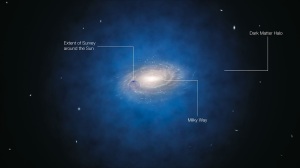
The earliest direct detection experiments started in the 1980s, and the first large, noble-liquid detectors came online in the early 2000s. The previous P5 report, approved by the High Energy Physics Advisory Panel in 2014, recommended building a second generation of dark-matter detectors that were at least 10 times as sensitive. Detectors that fit that bill include two xenon-filled experiments—called LUX-ZEPLIN and XENONnT [both below]—and one argon-filled experiment, called DarkSide-20k.
But as direct detection experiments grow, they face a looming barrier: the neutrino fog.

Neutrinos are nearly as difficult to detect as dark matter is. These ultra-lightweight particles cascade to the Earth from the sun and the upper atmosphere—induced by cosmic rays and rarely interacting with anything. That means that, even under a mile of rock, it’s basically impossible to keep them from passing through a dark-matter detector. A block of lead a light-year thick would succeed at blocking just half of them.
For now, neutrino interactions in a detector are so rare that they’re unlikely to interfere with the search for dark matter. But as experiments get larger, neutrino interactions will eventually occur frequently enough that they’ll create a “neutrino fog,” obscuring physicists’ view of anything else.
The P5 report acknowledged that the next generation of WIMP detectors might be as big as they can get before descending into the fog. “They will really be the ultimate search that can be made without changing the technology in some way,” says Richard Schnee, head of the South Dakota Mines physics department and a member of P5.
Making it to that size limit is necessary to ensure the direct-detection experiments cover all the ground they can, Yu says. “It’s worked really well, we know what to do, and we’re really close to covering all of the parameter space that we can with the technology,” Yu says. “It would be a bit of a shame to stop short. So there’s this motivation to see things through.”
A noble choice
Rameika named two collaborations as possible candidates to build the generation-3 dark-matter experiment: the XLZD consortium, representing liquid-xenon-based experiments XENON, LZ and Darwin; and the Global Argon Dark Matter Collaboration, with members from DarkSide and other liquid-argon-based experiments such as Canada’s DEAP.
Building both would be ideal, but “funding two does not appear feasible,” the P5 members wrote in their report. Instead, the P5 report recommends the US build a single generation-3 dark-matter detector. That means US-based scientists might need to choose.
There are advantages and disadvantages to building a detector with either noble gas, Maricic says. A decade ago, xenon was the clear winner in terms of abundance. Both xenon and argon exist in Earth’s atmosphere, but when argon is exposed to the sun, a tiny fraction of it is transformed into a radioactive isotope that’s not suitable for dark-matter searches.
But in 2008, scientists discovered argon in carbon dioxide wells near a volcanic plateau in Colorado, where it’s been sitting, protected from cosmic rays, since the formation of the Earth. Scientists pulled argon from these wells to fill Darkside-50, the predecessor to DarkSide-20k. And teams based in the US and Italy have nearly completed a plant to extract several hundred kilograms of the unspoiled argon per day, says Cristiano Galbiati, a professor of physics at Princeton and spokesperson for the Global Argon Dark Matter Collaboration.
Akerib, of course, prefers the more tested xenon-based dark-matter detectors, which have a 15-year track record across multiple experiments. “The risks are well enough understood that we can say, ‘This is not technically easy, but technically tractable,’” he says. “Now is really the time to do that experiment.”
Looking ahead
Gathering enough noble gas isn’t the only trial associated with building a generation-3 dark-matter experiment, says Natalie Roe, associate laboratory director for physical sciences at the DOE’s Lawrence Berkeley National Laboratory. Roe chaired a subpanel of the High Energy Physics Advisory Panel tasked with evaluating the scientific importance and technical readiness of proposed high-energy physics facilities.
It will be a challenge for the proposed larger detectors to maintain the high-voltage fields necessary to amplify dark-matter signals. And both xenon and argon can be contaminated with radon, which could mask a dark-matter signal. Larger dark-matter experiments will need exceptionally precise ways to test their material for radon before use. “Those are the areas for R&D,” Roe says.
She says it’s R&D well worth pursuing. The subpanel she chaired deemed building a generation-3 dark-matter experiment “absolutely central” to the future of physics.
Because there is still so much to learn about the different technologies, the decisions about the US plans for a generation-3 dark-matter detector will take a few more years to resolve, Rameika says. Scientists will be watching to see how sensitive the generation-2 experiments are and how well they manage background noise.
It’s also not yet clear how much funding will be available when it’s time to build. Leaving options open for now gives physicists time to solidify the international collaborations that will be necessary to support the cost of these experiments.
In the near term, DOE is asking physicists to research and propose answers to two questions: What should the detector look like? And where should it be built? The agency needs to see more data on both of those fronts before committing to any particular generation-3 experiment, Rameika says.
If the science—and funding—align, it’s possible the US could build two generation-3 experiments, one using argon and one xenon. If dark matter is spotted in one, physicists will need to confirm the observation using a different technology.
This is the same philosophy behind the design of ATLAS and CMS, two different detectors at the Large Hadron Collider that together confirmed the discovery of the Higgs boson. “If you do see something, you really want to be able to study it in as much detail as possible,” Yu says.

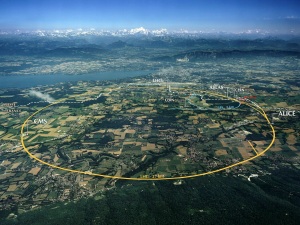
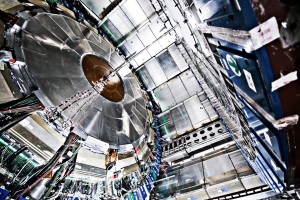
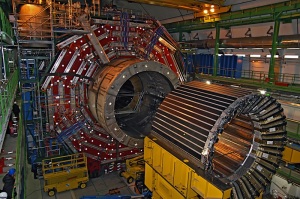
But if a generation-3 experiment fails to find dark matter, it won’t be the end of the road. The neutrino fog, for one, may not be impenetrable forever. Physicists are always devising tools to push their experiments to the next level.
Maricic says the search reminds her of the effort to detect gravitational waves, ripples in spacetime first predicted by Albert Einstein in 1916 and finally observed in 2015. By that scale, the discovery of dark matter in the next decade would be right on time: Theoretical hints of its existence first emerged in 1933.
“In these big discovery searches, one should not be easily discouraged,” Maricic says. “What to do in the next phase depends how compelled you are that there is still an exciting discovery worth searching for. WIMPs definitely fit that bill.”
_______________________
Dark Matter Background


Fritz Zwicky discovered Dark Matter in the 1930s when observing the movement of the Coma Cluster. Vera Rubin a Woman in STEM, denied the Nobel, some 30 years later, did most of the work on Dark Matter.

Thirty years later, astronomer Vera Rubin provided a huge piece of evidence for the existence of dark matter. She discovered that the centers of galaxies rotate at the same speed as their extremities, whereas, of course, they should rotate faster. Think of a vinyl LP on a record deck: its center rotates faster than its edge. That’s what logic dictates we should see in galaxies too. But we do not. The only way to explain this is if the whole galaxy is only the center of some much larger structure, as if it is only the label on the LP so to speak, causing the galaxy to have a consistent rotation speed from center to edge.


_______________________
Dark Matter Research


Another view of The LBNL LZ Dark Matter Experiment
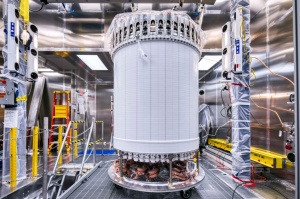







_______________________
See the full article here .
Comments are invited and will be appreciated, especially if the reader finds any errors which I can correct.

five-ways-keep-your-child-safe-school-shootings
Please help promote STEM in your local schools.



